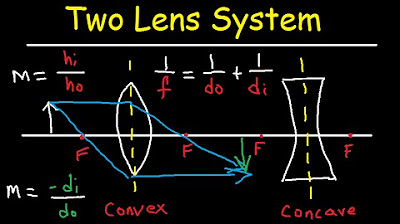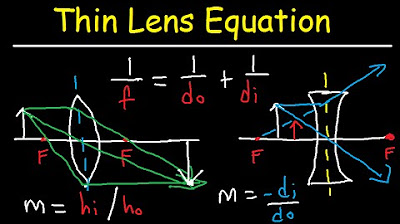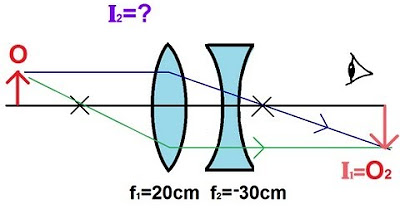GCSE Physics - How to Draw Ray Diagrams #70
TLDRThis educational video tutorial explains the process of drawing ray diagrams for both concave and convex lenses. It begins with the concave lens, illustrating its diverging effect on light rays and how to represent it with a diagram, including the lens symbol, axis, and focal points. The video then demonstrates how to draw an image using ray tracing for a concave lens, noting the virtual, upright, and smaller image characteristics. It proceeds to convex lenses, showing how they converge light to a point, with a similar step-by-step guide for drawing the ray diagram and commenting on the real, inverted, and smaller image produced. The video also touches on different scenarios for convex lenses, such as when the object is at varying distances from the lens, and the resulting image properties.
Takeaways
- 🔍 The video explains how to draw ray diagrams for both convex and concave lenses.
- 🌌 Concave lenses are diverging lenses that spread out light rays and are represented with outwards pointing 'V' shapes.
- 📏 An axis is drawn through the middle of the lens, with focal points labeled 'f' on either side.
- 📍 Additional points labeled '2f' are placed twice as far from the lens as the focal point, important for convex lenses.
- 🐔 An example of drawing a ray diagram is given using a 'chicken' as the object.
- 💡 Incident rays are drawn from a point on the object: one parallel to the axis and one towards the lens center.
- 🔄 The ray through the center of the lens remains undeviated, while the parallel ray is refracted towards the focal point.
- 📉 For a concave lens, the image formed is virtual, upright, and smaller than the object.
- 🔄 For a convex lens, the 'V' shapes are inverted, indicating it narrows towards the ends.
- 🔍 The parallel ray for a convex lens is refracted through the focal point on the opposite side.
- 📈 The image formed by a convex lens can be real, inverted, and vary in size depending on the object's distance from the lens.
- 📚 In exams, students are usually given a simple object like an arrow, and rays should be drawn from the top for accuracy.
- 👀 If the object is between the focal point and the lens, the image is virtual, upright, and larger than the object.
Q & A
What are the main characteristics of a concave lens?
-A concave lens is a diverging lens that causes light rays to spread out. It is represented by a symbol with outwards pointing V shapes at either end, indicating that the lens gets wider towards its ends.
How is a concave lens represented in a ray diagram?
-In a ray diagram, a concave lens is represented with a horizontal line through the middle of the lens and outwards pointing V shapes at either end. Focal points are marked on either side, and sometimes additional dots are added at twice the distance from the lens as the focal point, labeled 2f.
What is the purpose of the axis in a ray diagram for a lens?
-The axis in a ray diagram is a horizontal line that runs through the middle of the lens, serving as a reference for the orientation and position of the lens and the light rays interacting with it.
What happens to a light ray that passes through the center of a lens?
-A light ray that passes through the center of a lens is not refracted and continues on in a straight line, maintaining its original direction.
How do you determine the angle at which a light ray is refracted by a concave lens?
-To determine the angle of refraction for a light ray by a concave lens, a virtual ray is drawn from the point where the actual ray hits the lens to the principal focus (f). The actual ray is then refracted such that it appears to have come from the virtual ray's path.
What is a virtual image and how does it relate to the use of a concave lens?
-A virtual image is one that appears to be located behind the lens. When using a concave lens, the image formed is always virtual, upright, and smaller than the object.
What are the differences in the representation of a convex lens compared to a concave lens in a ray diagram?
-In a ray diagram, a convex lens is represented with V shapes pointing inwards at the ends, indicating that the lens gets narrower towards its ends. The focal points are also marked, but the direction of the V shapes is reversed compared to a concave lens.
How does a convex lens affect the light rays passing through it?
-A convex lens, being a converging lens, bends light rays towards a focal point on the other side of the lens. A parallel ray to the axis will be refracted through the focal point after passing through the lens.
What type of image is formed by a convex lens when the object is beyond two times the focal distance?
-When the object is placed more than two times the focal distance away from a convex lens, the image formed is real, inverted, and smaller than the object.
What happens when an object is placed between the focal point and a convex lens?
-If an object is placed between the focal point and a convex lens, the refracted rays do not meet when traced forward. Instead, they are traced backward using virtual rays to find the point where they meet, resulting in a virtual, upright, and larger image.
What is the significance of the term '2f' in the context of a lens ray diagram?
-The term '2f' refers to a point that is twice as far from the lens as the focal point (f). It is often marked on a ray diagram and is used to illustrate the behavior of light rays at different distances from the lens.
Outlines
🔍 Understanding Concave and Convex Lenses
This paragraph introduces the concept of drawing ray diagrams for lenses, specifically focusing on concave lenses which cause light rays to diverge. The script describes the symbol used to represent a concave lens and the method to draw its axis, focal points, and additional reference points labeled '2f'. It also explains the process of drawing an incident ray from an object, such as a chicken, to determine the image formation using the principal focus. The paragraph concludes with a brief mention of the image characteristics for a concave lens: virtual, upright, and smaller than the object. The content sets the stage for a comparison with convex lenses in the subsequent paragraph.
📚 Ray Diagrams for Convex Lenses and Image Characteristics
Building upon the previous explanation, this paragraph delves into the specifics of drawing ray diagrams for convex lenses, which converge light rays. It outlines the initial setup involving the lens, axis, focal points, and the object from which incident rays are drawn. The paragraph details the refraction process for rays passing through a convex lens, emphasizing the differences in the lens representation due to its converging nature. It then describes the method to find the image formation point by tracing the refracted rays. The script also discusses various scenarios for object placement relative to the lens' focal distance and the resulting image characteristics, such as real, inverted, and size variations. The paragraph concludes with a note on the simplicity of objects typically provided in exams and the importance of drawing rays from the top to ensure accuracy in ray diagrams.
Mindmap
Keywords
💡Ray Diagrams
💡Convex Lenses
💡Concave Lenses
💡Focal Point
💡Principal Focus
💡2f (Two times the focal length)
💡Virtual Image
💡Real Image
💡Inverted Image
💡Upright Image
💡Object Distance
Highlights
Introduction to drawing ray diagrams for convex and concave lenses.
Explanation of concave lenses causing light rays to diverge.
Symbol representation for a concave lens in ray diagrams.
Drawing the axis and focal points for a concave lens diagram.
Importance of the 2f points in lens diagrams.
Assumption that the exam will provide lens setup information.
Process of drawing a ray diagram for an object using a concave lens.
Use of virtual rays to determine refraction angles for concave lenses.
Identification of the image point by crossing refracted rays.
Shortcut for drawing images when the object is on the axis.
Commenting on the image properties: virtual, upright, and smaller than the object.
Transition to discussing convex or converging lenses.
Difference in symbol representation for convex lenses.
Ray diagram setup for a convex lens with an object.
Refraction of parallel rays through a convex lens to pass through the focal point.
Determining the image location by crossing refracted rays for a convex lens.
Commenting on the image properties: real, inverted, and smaller than the object.
Different scenarios for image formation with convex lenses based on object distance.
Special case of object placement between the focal point and lens leading to a virtual image.
Conclusion and call to action for likes and subscriptions.
Transcripts
Browse More Related Video

Multiple Two Lens System with Diverging and Converging Lens

Thin Lens Equation Converging and Dverging Lens Ray Diagram & Sign Conventions

Convex and Concave Lenses

Ray Diagrams

Physics - Optics: Lenses (3 of 5) Lens Combinations - Converging & Diverging Lenses

Why Does Light Bend? | Concave & Convex Lenses | The Dr Binocs Show | Peekaboo Kidz
5.0 / 5 (0 votes)
Thanks for rating: